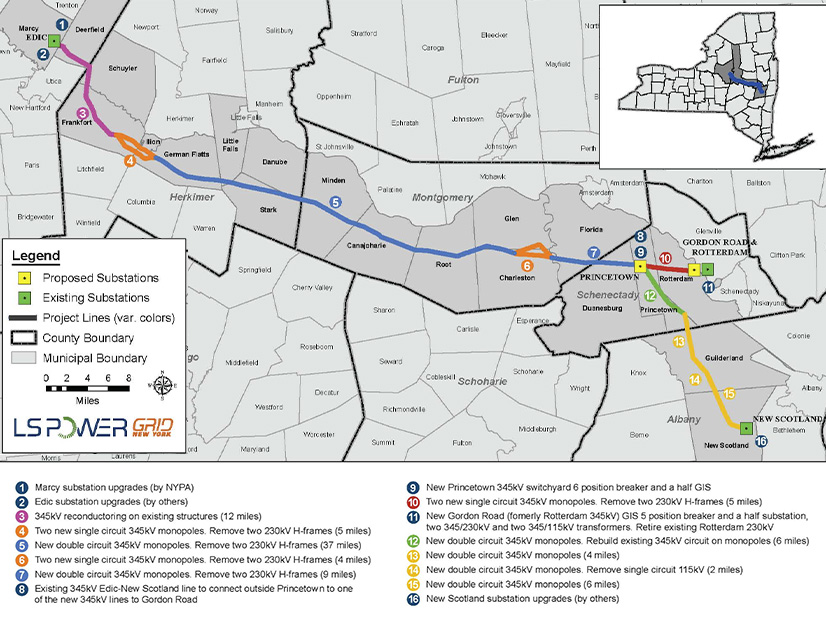A major transmission project completed last year is already alleviating congestion on a historic chokepoint between upstate and downstate New York. On its blog, NYISO claims these upgrades, particularly to the Central East Interconnection, have paid dividends, reducing wind energy curtailments along the transmission corridor.
NYISO claims these are the most significant upgrades in 30 years, boosting the transfer capability by about 1,000 MW.
The Central East Interconnection slides through the hills of upstate New York along the relative smoothness of the Mohawk River. It forks, hooking into the rest of the grid at Schenectady and southward out of the river valley into New Scotland, a distant suburb of Albany.
“Albany was functionally downstate,” said Marguerite Wells, executive director of the Alliance for Clean Energy New York (ACE NY). “Even though nobody in Albany thinks they live downstate and nobody in New York City thinks that Albany is anything other than upstate.”
The bottleneck grew out of multiple historical trends, including the industrial development along the Mohawk River and the piecemeal creation of the power grid. The last time the corridor was updated was during the 1960s.
“The issue was that this whole corridor … they had old, existing 230-kV transmission lines as well as some old 345-kV lines,” said Girish Behal, vice president of projects and business development for the New York Power Authority. “These were old existing transmission lines in old existing corridors that over a period of time got utilized to a point where you couldn’t put more energy on it.”
Behal likened the upgrade to transforming a state road to an interstate highway, using the same right of way but upgrading the engineering specifications to allow more capacity.
“It increased the Central East interface thermal transfer limit by 350 MW and the voltage transfer limit by 875 MW — a significant amount of capacity on those transmission lines to move those electrons around,” he said.
About 93 miles of new lines were from new steel monopoles from Albany County to Oneida County, effectively quadrupling the power through the corridor.
Curbing Wind Curtailment
NYISO says the upgrades mean this chokepoint on the grid has opened. Wind curtailments, once a norm, have plummeted. In December 2023 in the early evening, the interface flow for Central East surpassed 3,000 MW for the first time since 2005.
Before the upgrade, the Capitol District was powered mostly by gas turbine plants. Much of the new power comes from renewable sources. According to NYISO, about 30% of the state’s installed wind capacity is in the Mohawk Valley.
In 2023, NYISO asked wind generators to turn off to the tune of 162 GWh because the grid could not handle the energy. Roughly 80% of those requests came in the first four months of 2023, before the upgrades to Central East were completed.
“It’s not incorrect for … NYISO to say that the Central East Interface improvement unbottles wind because it unbottles the whole state,” Wells said.
Wells explained that this particular upgrade helps the entire state move power more effectively. Because upstate has more renewable energy than downstate, this effectively unbottled wind without touching the transmission infrastructure that hooks directly to wind generation.
She said the next phase of upgrades to transmission would directly improve the lines that attach to wind generation, reducing curtailment even further.
A big step in a massive process
This is far from the only upgrade that’s necessary for New York’s energy transition. At the ACE NY fall conference, Bart Franey, a vice president at National Grid, said some of the circuits in need of upgrades are over 100 years old.
“They were designed to basically import 100 MW. Now they’re being asked to export 1,000,” Franey said in a panel on transmission infrastructure. “What we’ve come up with, supported by the state, is what we call the Upstate Upgrade. That’s 1,000 miles of rebuilding and modernizing upstate New York transmission.”
Schuyler Matteson, the clean energy planning lead for the New York Department of Public Service, echoed these comments.
“We live in a state that has some of the oldest electrical infrastructure in the world — not just the region, but in the world,” Matteson said. He ran through the preliminary results of the Coordinated Grid Planning Process, saying that to meet the state’s generation needs, the number of interconnections would have to triple. “Then we need to find ways to get those electrons to customers.”
Later in the panel discussion, Franey and Matteson made it clear the 1,000 miles of new upgrades were just the beginning and not all of that would involve new transmission lines. They mentioned dynamic voltage support, grid-enhancing technologies and other avenues to make the best use of existing infrastructure and rights of ways.
In an interview with RTO Insider, Behal also emphasized the Central East Interconnection upgrade was far from the last upgrade needed. New York, as the birthplace of the electrical grid, has many sections in need of refurbishment.
“We have some transmission lines in upstate New York that were built in the 1940s,” Behal said. “It’s an antiquated system that now, with renewable generation coming in and trying to connect there’s a very significant need to upgrade those to a higher voltage or higher conductor size.”




